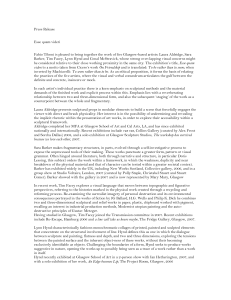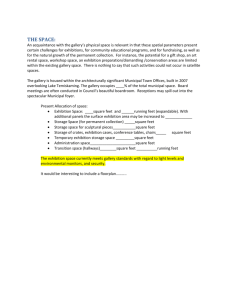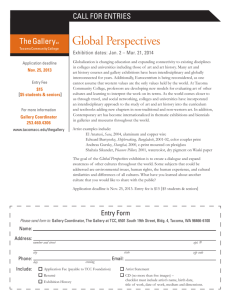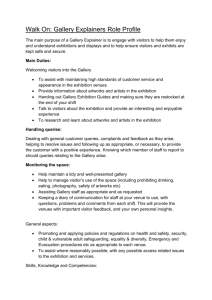Torn Gestures, Solo Exhibition, OUTPOST GALLERY
advertisement
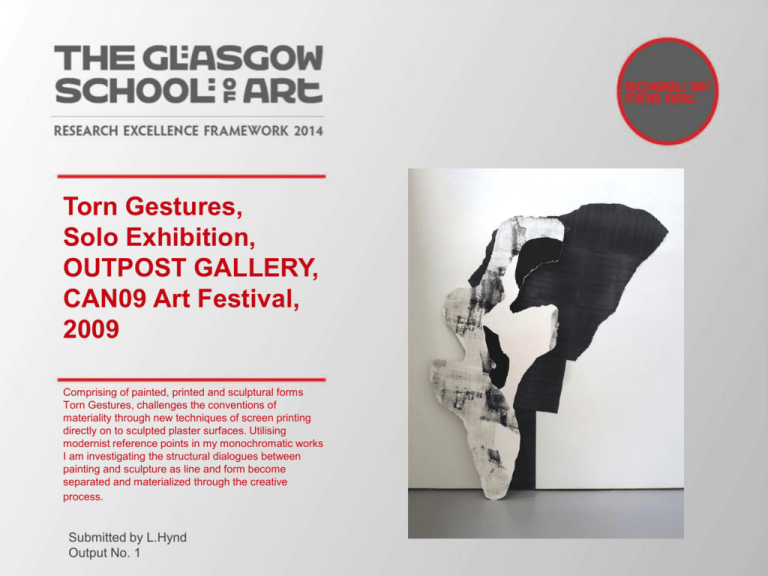
Torn Gestures, Solo Exhibition, OUTPOST GALLERY, CAN09 Art Festival, 2009 Comprising of painted, printed and sculptural forms Torn Gestures, challenges the conventions of materiality through new techniques of screen printing directly on to sculpted plaster surfaces. Utilising modernist reference points in my monochromatic works I am investigating the structural dialogues between painting and sculpture as line and form become separated and materialized through the creative process. Submitted by L.Hynd Output No. 1 Torn Gestures, Installation view, 2009 A commissioned new body of work which was supported and funded by the Scottish Arts Council and OUTPOST Gallery, and exhibited in a Solo exhibition in OUTPOST Gallery as part of CAN09 in Norwich. iam interested in exploring the tensions between the painted surface and the inherent object-ness of the works without them ever becoming exclusively identifiable as objects. In Torn Gestures I presented three new works consisting of large scale life size plaster sculptures and prints that dominated and articulated the gallery space with a new language. The relationship between solid and void and the importance of line within this dialogue is of particular interest to me. The play between the ambiguous nature of these elements enable me to unearth previously obscured areas which I refer to as ‘obstacles of vision’ or ‘blind spots’. My practice based research is focusing on the relationship between line and form. This exploration was carried out through the performative potential of line in relation to object and its existence in an ongoing structural dialogue between painting and sculpture. Monochromatic collages are screen printed directly onto a plaster surface, challenging the conventions of materiality. This method allows me to explore the tension between the painted surface and the sculptures inherent material form. Concentrating on the structural involvement of line within this dialogue, between flatness and depth, solid and void and two and three dimensions, Image one & a description of what we are looking at in the context of the project. Installation view of Torn Gestures, 2009 OUTPOST Gallery Lynn Hynd ‘Solitary Act’ was a large scale two-dimensional plaster works which combined screen printing on plaster and a torn photocopied college form. Inarticulate is a collaged print work which seeks to read as a piece of inarticulate language within the wider structural dialogue of exhibited forms. Torn Gestures was a large scale plaster work which was constructed out of three two- dimensional sculpted elements which interlocked and pulled apart the surface reading between the plaster, print, and wall. Inarticulate, 2009, Collaged screen print on paper, 85cm x 59 cm Solitary Act, 2009, Screen print, plaster, photocopy paper, 1.65m x 2.1m x 2cm 3 Torn Gestures, 2009, Screen print, plaster, 2.70m x 2.05m x 2cm 4 Torn Gestures, Detail of Print on plaster, and void space connecting to wall 5 “I dream of inside and outside, top and bottom, here and there, today and tomorrow. And inside, outside, top, bottom, here, there, today, tomorrow, mingle, interweave, dissolve. This lifting of borders is the way that leads to essential” Hans Arp originally written in German Connecting with Hans Arps, position that art “should not try to reproduce nature but should be an autonomous creation whose coming to life is as natural as that of a plant” (Eric Robertson, Arp painter, poet, sculptor, P.88), my practice based research has developed over the last 8 years alongside the concerns of key artists and theorists Bataille (Base materialism), Henri Mattisse, Richard Tuttle, Eva Hesse and contemporary artists Haley Tompkins and Monica Grzymala. The concerns around the involvement of process and its physical manifestation during twentieth century art, is when drawing was released from its referents and its two-dimensional grounding on paper or canvas. By separating the line from the ground I am enabling the line to constitute and articulate the ground rather than the ground preconditioning the drawing or the line. This slippage between territories and placement is a Image one & a description of what we are key theoretical concern as the line is set loose and materialized looking at in the context of the project. within the work. Hans Arp, Homme, moustache, nombril, c. 1960, painted cardboard Richard Tuttle, New Mexico, 1998, Acrylic on plywood Monika Grzymala, Ruptures, Installation view, 2009, Tape 7 “Drawing because of its status as becoming (blot becoming mark, mark becoming line, line becoming contour, contour becoming image, image becoming sign. The direction of this movement being reversible) posits a continuum of senses, from one sense of “senses” to another.” P100, Stage of Drawing, Gesture and Act, selected from the Tate collection by Avis Newman The processes of the work arriving at a structure in which space, edge, shape have become actual rather then depicted is where the work sits as the discrepancies between territories become fragmented. As the title suggests, the sculptures in Torn Gestures appear fragmented, like torn paper subtracted from a larger surface, leaving behind a trace of the original compositional structure. I see the significance of this separation as an ‘amputation’ or ‘cut’ from a wider sculptural dialogue. Referencing artists such as Hans Arp, who theorised that there is, “a cut that separates humankind from the goal it longs for oneness” I am materializing and challenging the fragment with in conversations of the creative process. In Torn Gestures I describes these broken objects acting as “garments of interface”, suggesting a dialogue between sites of meaning. The works’ original significance, created by their spatial placement is transformed as these gestures begin to exist in their own right, punctuating their own language. Contextual exhibitions Stage of drawing, Gesture and Act, Selected by Avis Newman, Tate Liverpool, 2004 Freeing the line, Curated Catherine de Zegher, by 2006, Marian Goodman Gallery, NY. On line, drawing through the twentieth century, 2010, MOMA. A withdrawn form, 2007, printing ink and spray paint on paper, 37cm x 60 cm 8 “Liberate the eye and mind to roam in tandem from sensation to disinterested, even disembodied thought, and back again to sensation”. Richard Tuttle Preceding this period of research, two selected exhibitions that are strongly connected to my research development and that were also both supported through external funding were Iain Hetherington and Lynn Hynd, at Glasgow School of Art, in 2007 and Esse quam videri, at Fabio Tiboni Arte Contemporanea, Bologna, Italy in 2008. At this point the work had an emphasis on sculptural methods and the material demands of the finished work and the explicit process within this. The emphasis lay with a reverberating relationship between two and three-dimensional form, and also the subsequent ‘staging’ of the work as a counterpoint between the whole and fragmentary. The position of the ‘fragment’ was a key within these earlier presentations as I challenged the boundaries of a form, seeking to produce works suggestive in nature, opening them up to being seen as a trace of a work rather than a work in itself. The articulation and dislocation of the line as a physical cut and how it became materialized was key to the reading of these works. The works both articulated and blurred boundaries. The layered constructed nature of the work meant that the white forms were solidifying the black forms but also the white forms (empty) had gained a positive virtue of the black that surrounded them. Image one & a description of what we are looking at in the context of the project. Acts of conscious Freedom, 2008, printing ink, photocopies and paper, 2.57m x 1.52m “I would make an analogy here between how we experience unconscious emotions in the repetition and accumulation of marks and the intonation, hesitations, and inflections of speech all of which hold a complexity of messages and can be at odds with what appears to be said, but which nonetheless determine meaning.” Avis Newman “As the thought comes to me to exorcise and transform this black with a white drawing, it has already become a surface. Now I loose all fear and begin to draw on the black surface.” Hans Arp Immediately following Torn Gestures I exhibited another solo presentation Taking apart and putting together like arguments in Ten till Ten Gallery in Glasgow,2009. (Funded by the Scottish Arts Council). This exhibition further extended and deepened the questions that had arisen In Torn Gestures, to do with surface, breakage, materialisation and hesitation as line and form moved and communicated freely within the memories of a conversation. Slippages, 2009, plaster and screen print, 76 cm x 62 cm Within the surroundings of this domestic space the works became isolated and layered within the context and were able to detach themselves from there materiality. The work begs to be experienced rather than read. It is as if the work, sees itself seeing, touches its touching, is visible and sensitive to itself. Installation view of Gesture and Act, 2009, 1.7m x 2m and A thing and Itself, 2009, 90cm x 81cm both screen print on plaster 10 A subsequent presentation in 2010 at Limoncello, London, Father Perspective Mother Space with Laurence Figgis, curated by Matt Williams saw the detachment of the line extend to a point where the materiality of the work took over and at points consumed the viewer. There is this sense that the languages of flatness and space, destruction and renewal are becoming ‘humanised’ within my practice. Think of such fables as “Who Killed Illusion” or “How the Edge Revolted against the Center ” . “ The Man Who Violated the Canvas” could follow “Where Did the Frame Go?” It would be easy to draw morals: think of “The Vanishing Impasto that Soaked Away – and Then Came Back and Got Fat”. And how would we tell the story of the little Picture Plane that grew up and got so mean? How it evicted everybody, including Father Perspective and Mother Space, who had raised such nice real children, and left behind only this horrid result of an incestuous affair called Abstraction, who looked down on everybody, including – eventually – its buddies, Metaphor and Ambiguity; and how Abstraction and the Picture Plane, thick as thieves, kept booting out a persistent guttersnipe named Collage, who just wouldn't’t give up. The shape of the thought I am after, 2010, screen print, plaster, 75cm x 47cm Brian O’Doherty, Inside the White Cube, 1976 Disagreeable, 2010, Unique screen print, 30cm x 42cm 11 In 2012 I followed with a solo exhibition of new research material which was supported by the Hope Scott Trust tilted Collisions in the process of Feeling Obstacles, at Duchy Gallery, Glasgow. The works were plaster and paper based and challenged the methodology around the process of print within my creative practice. Having advanced the line it is currently positioned within the complexities that occur through the ‘making’ process. Concerned with slowing the consideration of the mark so that it does not move too quickly towards line, contour, figure or image, I allow it to hesitate on the edges. The particularities of surface in the work create an imaginary space for the viewer which, to use Roland Barthes' phrase, 'garbles the chain of message, sign, gesture'. I sees the work becoming humanized within the intonation, hesitations, inflections, repetition and accumulation that occur within the materialisation of these thoughts. Left hand side: Arguments one doesn‘t speak of, 2011, screen print on paper, felted card, 3.7m x 3.5m 12 Material and Act 'Separation of a master from its serial The works have developed out of a very physical and production, serial break-up of a pieces but not process based research practice. just simply in its spatial placement, but how it and been readsinterested as a newinpiece'. Author Ievolves have always the problem of the edge, unknown as this point with inhabits both the two-dimensional and three-dimensional reading of something. The edge to me is like a line. It is both physical and flat in its reading, Even though works more physical What's key the within theinvolve context of this bodymaterials of they and hold of a strong relationship workare is still the flat materiality temporality of theto the wall. The wall isprocess. such an important dimension and surface creative within the reading of the work. The wall is the ‘ground’. And through investigating the line and edge, I am interested in how the separation of the line from the ground would allow the line to constitute and articulate demonstrates interest in drawing as a setthe the ground ratherher than the ground preconditioning of actions which convey sensations before drawing / line. and beyond language, but also in drawing as an exploratory medium The inclusion of screen-printing in the work applies notions of time and the perishable form to a medium that is conventionally about the repetition of a solid body of printed material. I am focused on not being constrained by a technical procedure but allowing the mark making to emerge and become active. The fluidity of the surface marks in the collaged printed surfaces come through explorative mark making with drawing with the water hose directly onto the screen before printing. I wanted the works to have this sense of breathing in and out, to have a movement that retained this raw process of thought. The involvement and use of the print process has now developed with the use of directly drawing with squeegee tool, enabling a wider punctuation to occur within the linguistics of the artwork. The motif seems to be trapped in some way in the print, as if a glitch in a film real – opening up wider structural interests when seen alongside a larger dialogue of prints. This interest in visualising the serial, rhythm of the process embedded within the printed work contributes to a depth of enquiry to how the material and the 'act' sit together within the boundaries of artistic practice. The material and raw processes sit on the surface of the works, agitating the operation of thought. Focusing on an interest in the processes and operations that render form and content unstable, these latest outputs pulse within Image onetheoretical & a description of what we are the confines of their material, technical and looking at in the context of the project. boundaries. The research material displayed in Torn Gestures was disseminated though out the month long exhibition to a wide variety of both public, student, festival visitors, curators, artists and gallerist’s. And a commissioned text by curator Andrew Hunt, titled Blindness for Iain Hetherington and Lynn Hynd at Glasgow School of Art. As part of the dissemination of my research I delivered a talk in the gallery, which was open to anyone who had an interest in what was exhibited. The activities of the exhibition were further dispersed through two international reviews. One was a two page review, titled ‘Colin Perry enjoys the ‘pleasure of not knowing’ in the sculptural collage of this Glasgow based artist’ within MAP Magazine an international art magazine. The second was a review of the exhibition in the Guardian Newspaper as The best art shows to see this week. Preceding this dissemination my larger body of research has been distributed through an exhibition catalogue and commissioned text by Darren Rhymes for Esse quam videri, Fabio Tiboni Arte Contemporanea. Image one & a description of what we are looking at in the context of the project. EMERGING: LYNN HYND Colin Perry enjoys the ‘pleasure of not knowing’ in the sculptural collage of this Glasgow-based artist Lynn Hynd’s latest works are unsettling post-painterly objects that can’t seem to settle down in any conventional dimension. Over the past century we have seen the humble collage, with its radical cut-n-paste techniques, evolve and shift into video editing, sculpture and architectural design. But collage cannot abandon the flat surface entirely. Recent works by this Glasgow-based artist find resonance from the existential threat posed on the two-dimensional world by a pair of scissors. In a game of Stone-Paper-Scissors, it’s as if someone has removed the stone from the game, leaving the remaining ill-matched opponents to a showdown. Hynd’s work often composes meandering strips of paper to float freely in corners of real space and drape from walls as if they don’t want to let go. They are reminiscent of Edwin Abbott’s strange Victorian allegory Flatland: A Romance of Many Dimensions by A. Square, 1884, in which a two-dimensional ‘square’ protagonist stumbles upon an inexplicable world of three-dimensional forms. Following his traumatic encounter with ‘Spaceland’, and his failure to communicate the potency of this world to his flat peers, he is a damaged wreck, ‘not the Square he once was’. Hynd’s exhibition Torn Gestures at Outpost, Norwich, extends these paper-based investigations through a set of flat objects propped like planks against the gallery walls. Entering Outpost’s modest cube-like space, the first thing you notice is the rhythmic pattern of the works: a wall-mounted black and white collage anticipates a set of bronchial, coral-like shapes made of plaster. They are arranged with the pulsing rhythm of jazz-era album design, Jackson Pollock’s ‘Blue Poles’, 1952, or the trilling glyphs of Len Lye’s ‘Kaleidoscope’, 1935. With sheer, flat surfaces, and a depth of only a couple of centimetres, these are something less than sculpture and something more than painting or collage. Striking too, are the surfaces of these objects, embellished as they are with stark zones of liquid darkness and delicate penumbral areas of hatched, hand drawn markings. Up close, one notices these patterns are printed directly onto the plaster’s surface, a tactile quality not easily reproduced in photographic documentation. There’s a jocularity to this artificiality too, as if we are encountering the tawdry stage trickery of early cinema in the flesh, not filtered by the drama of cinematic projection. The audience has been allowed to go behind the camera, to stick a finger into the gothic shadows of fake Faustian trees, and to rub off the heavy eyeliner from cool-eyed vamps and flappers. It’s only up close you notice the worry lines behind the make-up. If there’s a flickering ontological uncertainty in Hynd’s work, oscillating between two- and three-dimensions, there’s also a sense of poetic matter-of-factness. Like Hayley Tompkins’ coy ‘Metabuilds’, or a discretely northern European version of Mary Heilmann’s giddy pink-and-black painting, ‘Save The Last Dance for Me’, 1979, Hynd’s work favours the intimacy of material presence over clever conceptual trickery. Such material frankness is rare in an art world that often treats hermeticism and self-referentiality as a mark of intelligence. Like Heilmann and Tompkins, this intimacy is both staged and real, suggesting a theatre of human communication through the interaction of forms. It’s hard, for instance, not to notice the way the plaster forms touch and nod towards each other like cavorting harlequins. Hynd operates as a painter in a postpainterly world. Bur instead of positing her work immediately after the dissolution of painting, it can be seen as pushing outwards into alien territory. It engages with a history of what might be termed ‘expanded painting’ – not necessarily as a critique of the medium, but rather proposing a broadening of its terms. Hynd explains this succinctly when she stated to me ‘the wall is the canvas’. 15 You wouldn‘t know it from Torn Gestures, but until 2005, Hynd’s work was laden with the evocativeness of parlour room decadence. Often using beautifully veneered furniture, such as wardrobes, display cases and dressing table mirrors, the sensation of fin-de-siècle decay seemed to overpower her more tentative material investigations. For instance, ‘A Bound Enchantment’, 2005, is a horizontal wardrobe construction, the surface of which is covered in patches of détourned paper. ‘Gentleman’, 2004, meanwhile, is an elegant display cabinet, lined with intricately patterned wallpaper that the artist has cut and overworked with subtle markings. Since 2006, Hynd has dispensed with such cumbersome supports, explaining ‘the history attached to them was becoming disruptive to the reading [that] I was trying to challenge’. While Hynd’s works at Outpost resemble the blobby cellular forms of Juan Miró, Henri Matisse, and above all, Hans Arp, this referentiality is an incidental detail. Her practice certainly contains a smattering of modernist references (the collage ‘A Sculpted Moment’, 2007, includes an image of Man Ray’s ‘Kiki with African Mask’, 1926), but her practice neither depends on such connections nor does it make countermoves against such a heritage. Refreshingly, she does not reference modernism in an attempt to comment on it from the moral plateaux of contemporary life. From this standpoint, the haughtiness of hindsight seems both opportunist and bullish. Perhaps the most helpful historical precedent here is Arp’s ‘Collage with Squares Arranged According to Chance’, 1916-17. Constructed from a series of torn squares dropped at random and glued onto a support, this is a seminal work in anti-egotistic art making, a gesture towards the momentary and haphazard, and a pointed comment against contemporaneous expressionist paintings. Similarly, Hynd’s forms seem patiently unembarrassed by their simple genesis from studio practice. Displayed within the gallery, these object-like images (or image-like objects) are open-ended. Shown as part of her 2007 exhibition with artist Iain Hetherington at Glasgow’s Studio 40, a curved hoop of paper titled ‘A Withdrawn From’, 2007, resembles a question mark. Another work, ‘A family of forms caught between somewhere, this and there’, 2007, consists of an array of cut and torn paper forms scattered like musical notation across a gallery wall. The suggestion, it seems, is that we pick up on the grammatical directions and construct our own experience. Hynd says that ‘I want the works to activate and punctuate the language of the exhibition’, and speaks of the works as ‘fragments’ and ‘obstacles of vision’. Like a written page peppered randomly with full stops, Hynd’s work suggests a series of surprising stoppages. Sprawling through the gallery space, or poised coyly against architectural elements such as walls and windows, Hynd’s collages and objects harness the uncertainty of the edge – the division between two- and three- dimensions. The concept of ‘the edge’ is the central crux of her art-making: it’s a concept both simple and complex, bridging words and worlds with a barely visible step. Conflating this deferral of meaning with the generative power of language, the artist’s work basks in the pleasurable mystery of simply not knowing. Colin Perry is a writer based in London Lynn Hynd, Torn Gestures, Outpost Gallery, 2-21 June 16 Exhibitionist: The best art shows to see this week A group exhibition traces patterns in Leicester, truth conquers all in Glasgow, while in Norwich the Outpost gets torn up by plaster and paper http://www.guardian.co.uk/profile/lauramcleanferris Laura McLean-Ferris guardian.co.uk, Friday 19 June 2009 16.52 BST Article history Circles, lines, spots and stripes descend on the City Gallery in Leicester this week in Pattern Recognition, a major group exhibition exploring pattern in contemporary art. Here, Dryden Goodwin scratches careful, sometimes unnerving, patterns onto the surfaces of photographs he has taken, while Gemma Holt has fashioned together a carpet of block colours using tiles sized to her own measuring system (the 'G', also the basis for her G5 paper-sizing system). Holt has also created sets of pencils and biros, which she structurally bends, twists, bows and breaks to create visually pleasing shapes. Over in Glasgow, the Mary Mary Gallery is enticing visitors with Lorna Macintyre's poetic exhibition Sentences Not Only Words. Macintyre's work uses a combination of photographs and sculpture referencing French art critic Guillaume Apollinaire and Portuguese poet Fernando Pessoa. Her four-part sculpture Wine is Strong / A King is Stronger / Women are Stronger Still / But Truth Conquers All, is made up of four tall plinths corresponding to the four lines of the title. Each plinth is topped by a pencil-sized rod of copper; the first has one, the second two, until on the fourth plinth, four rods make the shape of a diamond. In another work, a black and white photograph of a tree stump in winter finds an echo in Macintyre's Winter Sculpture, a tree branch to which the artist has applied a fine layer of gold leaf. In Norwich, it's your last chance to catch Lynn Hynd's exhibition Torn Gestures at the artist-run gallery Outpost this weekend. Flat plaster sculptures lean against the gallery walls shaped like huge pieces of torn paper. The artist has screen-printed monochromatic collages directly on to the soft plaster of the sculptures, resulting in sections of blacks, whites and smeary greys reminiscent of old newspapers, scuffed by time and difficult to read. Glasgow-based Hynd refers to the works as amputations or cuts, citing the influence of collage artist and paper-tearer Hans Arp, who was interested in the "cut that separates humankind from the goal it longs for: oneness". SE8 is a new gallery in a former house in Deptford, an area of south London that seems to be attracting increasing numbers of artists. For the opening programme, Cabinets, artists are invited to exhibit their work in three cabinets of curiosity - or 'Wunderkammer' as they're also known.. The fourth exhibition in this season, currently on show, is Studies for Adam and Eve by Daniel Silver. Silver is a sculptor known for his exploration of the human head, and the cabinets here are filled with wonky, roughshod heads of plaster and clay, with eyes and noses in all the wrong places. Some spill out of pots, while others are carved in wood. Our heads, Silver reminds us, are always works in progress, and need constant attention. North of the river, in the West End, Polish painter Wilhelm Sasnal is a master of many different styles – flat, glossy, abstract, chalky, slick or pop – bound together by a unique way of seeing. Sasnal's latest show at Sadie Coles includes many works on the subject of food – namely, its transport and wastage, and the political and social economies connected to it. In his Untitled (rice), painted in 2000, a flat grey field spills out towards the viewer, peopled by stooped silhouetted figures that look as though they might be drowning in it. In another, unmarked black barrels gleam ominously – do they hold cooking oil or crude oil? These paintings are accompanied by quieter moments – a swirling, toothpaste-like wave breaking on to a shore, a black night sky, bare feet reflected in puddles on the beach. 17 Exhibition Selected Exhibitions preceding Torn Gestures Esse quam videri, (with Sara Barker, Laura Aldridge, Tim Facey, Conal MaStrivick, and Lynn Hynd), Fabio Tiboni Arte Contemporanea, Bologna, Italy, 2008 - Commissioned text by Darren Rhymes and catalogue produced for exhibition. Iain Hetherington and Lynn Hynd, Glasgow School of Art, 2007 – Commissioned text by curator Andrew Hunt. Selected Exhibition subsequently Taking apart and putting together like arguments, Solo show, Ten til Ten Gallery, Glasgow, 2009, (Scottish Arts council funded) Review by Ruth Barker. As you slip into Silence, (Sam Stead, Lynn Hynd), Intermedia Gallery, CCA, Glasgow, 2009, (Glasgow City council funded) Father Perspective Mother Space, ( Laurence Figgis and Lynn Hynd, curated by Matt Williams), Limoncello Gallery, London. Collisions in the process of Feeling Obstacles, Solo Show, Duchy Gallery, Glasgow, 2012, (Hope Scott Trust Funded) I would like to acknowledge the support and commitment of the Scottish Arts Council, OUTPOST Gallery committee, the CAN09 Festival to enable me to create this new body of practice based research.
